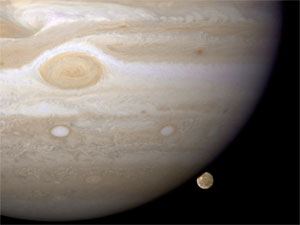A page from the "Causes of Color" exhibit...
Why does Mars appear red and Earth blue-green?

Jupiter, with the moon Ganymede visible behind, shows the famous red spot, seen through the Hubble Space Telescope. The orange and white bands are clouds of the gases white ammonia and orange ammonium sulphide.
Planets
Planets are an exception in the night sky, because we see them through the light they reflect – they are not sources of light. However, they do reveal remarkable colors in the light they reflect.
The variety of color in planets depends on a wide range of factors. If they have an atmosphere, the color we see may be related to weather effects in their atmosphere, such as the clouds on Venus, or to the gases themselves, on the gas giant planets of Jupiter, Uranus, Neptune, and Saturn. Earth looks blue-green from space, depending on cloud cover, because of the high proportion of water on the surface.
Planets with little or no atmosphere are seen in the color of their surfaces. Mercury is a rocky grey, while Mars is a butterscotch, reddish color (have a look at the Martian sky).
|
Mars
|
Jupiter
|
Saturn
|
|||
|
Neptune
|
Uranus
|
||||
|
The different colors of planets in the solar system. |
|||||









